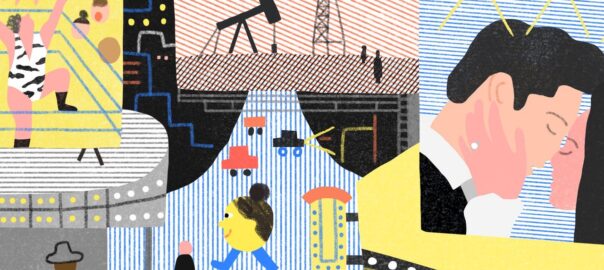[ad_1]
All-Male Hula, a Tennis Ballet
Outdoor dance is nice, but there’s nothing like being in a theatre, with its dramatic lighting and proscenium. At New York City Center’s popular and populist Fall for Dance Festival (Sept. 27-Oct. 8), twenty dollars buys an evening that might include the all-male hula troupe Kaleoolakaikahikinaokalā evoking Hawaii’s traditions through song, drumming, and movement (Oct. 3-4), or the ecstatic dancing of Brazil’s Grupo Corpo (Oct. 7-8).
New York’s two resident ballet companies take turns at Lincoln Center’s David H. Koch Theatre. First comes New York City Ballet’s seventy-fifth-anniversary season (Sept. 19-Oct. 15), devoted to the works of its founding choreographer, George Balanchine. The lineup includes a program (on Oct. 11) that replicates the company’s opening night, in 1948: the spare “Concerto Barocco”; “Orpheus,” Balanchine’s poetic take on the Greek myth; and the joyful “Symphony in C.”
American Ballet Theatre’s first New York season planned entirely by its incoming director, Susan Jaffe (Oct. 18-29), includes several one-act ballets, from Harald Lander’s “Études,” a celebration of ballet technique, to Alonzo King’s tensile “Single Eye.” Most resonantly, A.B.T. brings back Alexei Ratmansky’s “On the Dnipro,” about a Ukrainian soldier returning to his village after the First World War.
Christopher Williams reimagines Nijinsky’s lost 1913 ballet, “Jeux” (Baryshnikov Arts Center; Oct. 12-15), an exploration of the ambiguities of sexual attraction through the prism of a tennis match. And Van Cleef & Arpels brings a new festival, Dance Reflections, to the city (Oct. 19-Dec. 14). Among other offerings, Lyon Opera Ballet performs Lucinda Childs’s minimalist classic “Dance” (New York City Center; Oct. 19-21), and the Polish French dance artist Ola Maciejewska presents her tribute to the illusionism of Loïe Fuller (French Institute Alliance Française; Nov. 2-3).—Marina Harss
Art
Illustration by Jam Dong
Manet and Degas, Ruth Asawa, Ed Ruscha
“Barkley L. Hendricks: Portraits at the Frick” (opening on Sept. 21) marks a homecoming of sorts for Hendricks, who died in 2017, at the age of seventy-two. The exhibition places fourteen of his paintings, made between the late nineteen-sixties and the early eighties, under the same roof as the Old Masters to which Hendricks, their dedicated student, returned throughout his life. Like all the greatest portraitists, Hendricks rendered glimmers of his subjects’ interior lives via the particularities of their personal style, the poses they strike, and the precise wattage of their skin’s radiance, remaining steadfastly devoted to, in his words, “the beauty and variety of complexion colors that we call Black.”
A fateful first meeting of Édouard Manet (1832-83) and Edgar Degas (1834-1917) at the Louvre, in the early eighteen-sixties, led to a two-decade conversation—at times friendly, at other times charged by a less than collegial frisson—as each pursued his own audacious, masterly hand. “Manet/Degas,” at the Met (Sept. 24), brings together a hundred and sixty paintings and works on paper by these disparate titans, whose art became part of the radical terra firma in which modernism took root. Especially delectable among the exhibition’s many delights: Degas’s portrait of Manet and his wife, which rankled Manet so much that he sliced its canvas, and Manet’s succès de scandale “Olympia,” here in her American début.
The Whitney exhibition “Ruth Asawa Through Line” (Sept. 16) honors the artist’s daily drawing practice, highlighting the contemplations on paper of shape, light, and shadow—many made public here for the first time—which informed her airy and voluptuous wire sculptures. Also at the Whitney is “Henry Taylor: B Side” (Oct. 4), the first survey of the artist’s career over the past thirty-plus years, during which he has become best known for paintings that level our attention across celebrities, politicians, family, and friends alongside the incarcerated, the institutionalized, and the terrorized. “Support the Black Panthers” reads a banner hanging over one disquieting installation, comprising dozens of mannequins gathered around a podium and dressed in black leather jackets—all headless, yet somehow still self-possessed.
Indeterminacy, ephemerality, fluidity—these were some of the guiding principles of the Fluxus movement, which held that every moment of life had the potential to become, or to deliver, a work of art. Japan Society’s “Out of Bounds: Japanese Women Artists in Fluxus” (Oct. 13) showcases four of its under-sung genre-benders—Shigeko Kubota, Yoko Ono, Takako Saito, and Mieko Shiomi—who prove that what slips through the system often sticks to the spirit with greater force. The exhibition spotlights some of their pathbreaking performances, such as Ono’s “Cut Piece,” from 1964, for which audience members were invited to disrobe the artist one scissor snip at a time, and Kubota’s “Vagina Painting,” from 1965, which upended (so to speak) Abstract Expressionism’s long-crowing machismo.
[ad_2]
Source link
